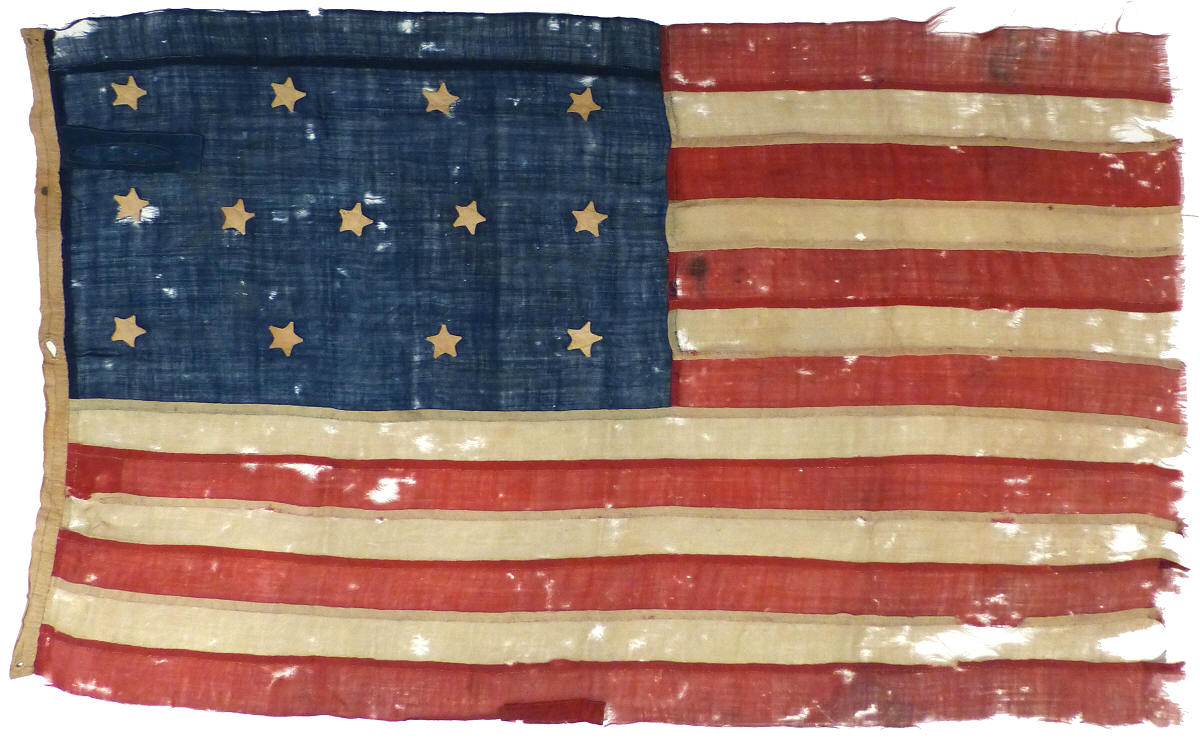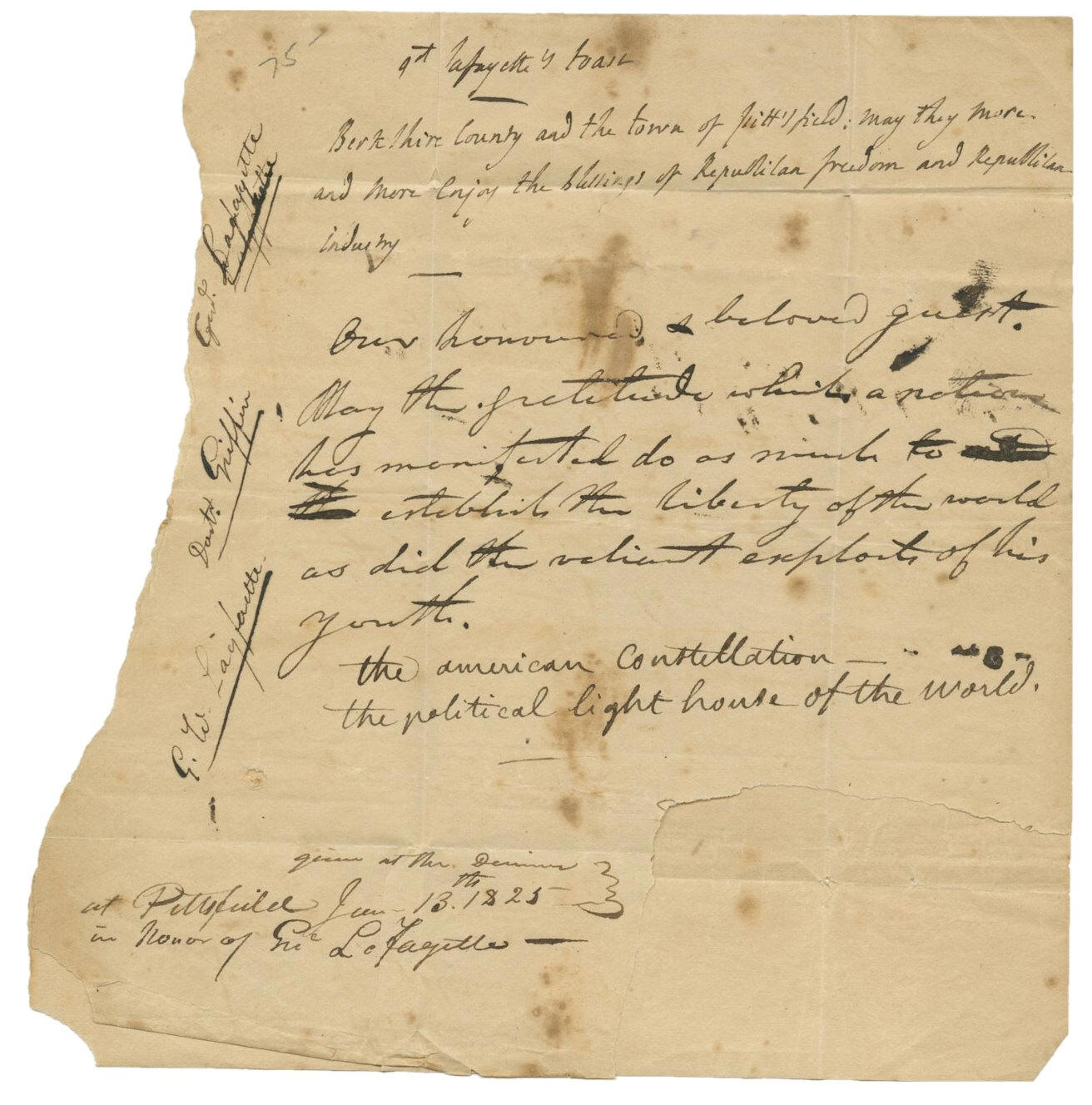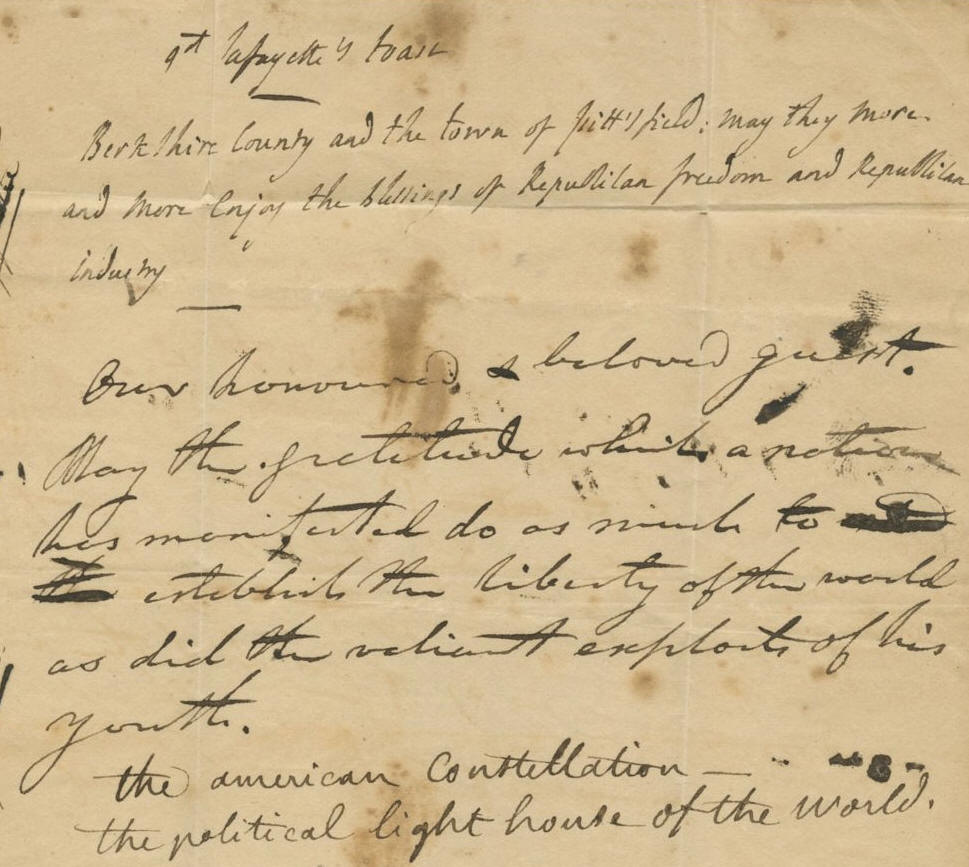|
  |
|
This extraordinary
grouping is one of the most fascinating in the Rare
Flags collection. The Marquis de Lafayette, famed
general of the American Revolution and beloved protégé
of George Washington, returned to America in 1824 for a
final tour of the country he fought for and loved.
For more than a year, from August 1824 to September
1825, Lafayette, accompanied by his son, George
Washington Lafayette, traveled through all twenty-four
states. His grand tour was one of the most
significant events in early 19th century America.
The generation of Americans who fought the American
Revolution was aging, and their fading flame inspired
nostalgia for the early, idealistic era of the birth of
the American Republic. By 1824, heroes such as
Thomas Jefferson and John Adams were growing old, and
had but few years left
before they too would pass away--Adams was 88 years old,
and Jefferson was 81. Incredibly, both would die on the
very same day, July 4,
1826, less than a year after Lafayette's tour ended and
he returned to France. Invited to America by his
friend, President James Monroe, Lafayette visited Monroe at the
White House. He visited Thomas Jefferson, James Madison and Dolly
Madison at Jefferson's home at Monticello, and John
Adams at his home in Braintree, Massachusetts. Along every
leg of Lafayette's journey, and at every stop, he was
hailed by adoring Americans of all ages, from young
children to old Revolutionary War veterans who
gathered in ever dwindling numbers.
Throughout the country, chapters of the Society of the
Cincinnati, founded in 1783 by officers of the
Continental Army and their French counterparts who
fought in the American Revolution, organized rallies and
processions for Lafayette, one of the last surviving generals of
the American Revolution.
A printed note
accompanying this 13 star American flag reads, "this
flag used in the Battle of Saratoga September, October
1777 accompanied General Lafayette 13 June, 1825 from
Albany to the Massachusetts state line". The other
document is a series of three toasts, the first in
Lafayette's own hand, the second in the hand of Rev. Dr.
Edward Dorr Griffith, President of Williams College, and
the third in the hand of Lafayette's son, George
Washington Lafayette, along with an annotation that
reads, "given at the dinner at Pittsfield June 13th 1825
in honor of Gen Lafayette". Astonishingly, the
flag and the toasts were
found in different places and acquired from different
people at different times; yet both relics have survived
as a cherished mementos of the same
event, on the same day, nearly 200 years ago.
Although he visited New
York and New England in the early part of his trip,
Lafayette
was again asked to return north prior to his departure
home to France in 1825. A new monument was planned at
Bunker Hill in Boston and the citizens of Boston
invited Lafayette to lay the cornerstone.
Lafayette returned to New York State in June, 1825, and
by mid-June, Lafayette had made his way to Albany, New
York. The story of the flag and the toasts begins
early in the morning of June 13, 1825. According
to records about General Lafayette's trip that day, the
General and his traveling party left Albany on horseback
at 6:00 a.m. and arrived in Lebanon Springs (now New
Lebanon, NY) at 2:30 p.m.1
The guestbook for the Columbia Hall hotel in Lebanon
Springs for that day describes the arrival of the
delegation accompanying Lafayette.
June 13, 1825,
Marquis de Lafayette and son, Gen. Solomon
Van Rensselaer, Col. Clinton, Capt. Spencer
and lady and two children, Mr. Norton, wife,
and two children; Col. Bloodgood, Major J.B.
Van Schaick, Col. John T. Cooper, Major P.
Seaton Henry, Major R. V. De Witt, Lieut.
Col. Knowlson, Major T. A. Bridger,
Surrogate; Capt. S. V. R. Bleecker, Capt.
Osborn, Capt. Hendrickson, Lieut. Webster,
Lieut. Volkenbrugh Shaukland, Adjt. Hazard,
Adjt. Brush, James Eryhts, Surgeon S. G.
Infantry.
The above, with Capt. Spencer's (of Col.
Cooper's Regiment) dragoons, formed part of
the escort to the Massachusetts line. Gen.
Lafayette did them the honor to express
sensible regret at parting with them. The
intention was for the escort to have gone on
to Pittsfield, but a little "brief
authority" deprived them of the anticipated
pleasure.2 |
Based on the note accompanying the flag, the flag
was carried in this procession to the state line.
Apparently the Massachusetts delegation turned the
New York delegation away, since the guest of honor was
now theirs for the evening. Lafayette then
travel from the Massachusetts state line to
Pittsfield, and after arriving in town, a grand
celebration followed. An account of the event,
published in 1876, describes Lafayette's visit to
Pittsfield, including a description of the dinner
and the toasts given that evening:
|
General Lafayette was welcomed to the
county, and the commonwealth, by Sheriff
Brown, and after acknowledgments made with
his usual grace and courtesy, he took his
seat in an elegant coach…richly festooned
with flowers, and drawn by four spirited
grays, bore him pleasantly and rapidly to
the village of Pittsfield.
The approach of the cavalcade to the village
was announced by bells and cannon, and
thousands of citizens from all parts of
Berkshire assembled in the park, and
neighboring streets, to greet the expected
guest, who, at a little before six o'clock,
alighted from his carriage, at the door of
Captain Herrick's coffee-house, and the most
enthusiastic cheers of the multitude.
On the green, between the church and the Old
Elm, a beautiful triumphal arch had been
erected; bearing in the center of the front
the salutation, 'Welcome Lafayette', and on
the sides, the names of the American
battlefields upon which he had most
distinguished himself. Above the arch hung a
well-proportioned national flag, forty-seven
feet long, which the ladies of the village
had made that morning, and which had been
suspended…from the top of the Old Elm,
where, in the favoring breeze of the day, it
floated with imposing effect.
General Lafayette, accompanied by the
committee, passed between two columns of
citizens and soldiery, to the arch, under
which he was addressed by Hon. Jonathan
Allen, in a few comprehensive and striking
remarks; to which he replied with much
feeling, expressing his reciprocation of
their affection, and a deep sense of the
unequaled honor bestowed upon him. He then
proceeded through two lines of
school-children to the church, where he was
addressed by Professor Batchelder, of the
Medical College, in behalf of the ladies of
Berkshire, who filled the house to
overflowing…He was here also introduced to
many of the clergy and to a number of
Revolutionary veterans, several of whom had
been his companions in arms.
He then returned to the coffee-house,
escorted by the Berkshire Grays - a favorite
military company…the citizens crowding upon
the procession, anxious to behold, and, all
who could, to touch the hem of his garment;
among them some of the leaders of the
Shakers, who, contrary to their custom,
approached the august personage with their
hats in hand.
At the hotel, a sumptuous dinner had been
prepared; the hall and tables being
decorated with evergreens and flowers,
mingled with paintings and standards, some
of great elegance, which attracted the
particular notice of the general and suite,
and the admiration of all.
A blessing was invoked by Rev. Dr. Griffin,
president of Williams College, in his usual
exalted style; and the closing benediction
was made by Rev. Mr. Bailey, in a very
appropriate and elegant manner, with a
solemn allusion to the recent catastrophe on
the Ohio.
A number of toasts were given; among them,
the following by Colonel Danforth: "Our
beloved guest. General La Fayette; the
companion in arms of Washington, Greene,
Gates and other brave officers of the
revolutionary army."
The General responded with the following
sentiment: "The citizens of Berkshire, and
the people of Pittsfield — may they continue
to enjoy, more and more, the benefits of
their industry, and the fruits of their
republican institutions."
The General's son, George Washington La
Fayette, gave as a toast — "The American
constellation; the political lighthouse of
the world.3
|
These
toasts are written by the men in their own hand,
with Lafayette, also writing "1st. Lafayette's
Toast" above his own.

The toast originally
surfaced at auction in 2012. It was acquired by the Raab
Collection, a renowned authority and foremost dealer in
rare autographs and ephemera. According to Steven
and Nathan Raab, "this toast is the only signed toast of
a significant 18th or 19th-century notable we can recall
seeing, nor has our research turned up any others. Since
toasts were ephemeral, and many were not even written
down, its survival is extraordinary. Manuscript mementos
from Lafayette's epochal tour of America are rare, and
important ones extremely so. This is the first we have
had." Likewise, the flag is exceptionally
rare and important. There are very few American flags
that survive from the earliest era of American flag,
generally considered those made prior to 1830. I
am not aware of any, in literature or in institutional
or private documented collections, that have
documentation directly linking them to Lafayette's
visit. The family in which this flag descended has
direct documented ancestors from Albany, NY who fought
in the Revolution, and the very specific reference to
the precise date of Lafayette's trip from Albany to
Massachusetts is excellent evidence that it was written
by a person with first hand knowledge of the event and
the flag's role in it. The flag does not date to the
1777 Battle of Saratoga, and in fact it's unlikely that
any flags in the stars and stripes format were fielded
during that battle, which occurred just months after the
First Flag Act describing the American flag was passed.
However its construction is consistent with flag-making
of the period from 1800 to 1825. Based on written
records, many 13 star flags were made and carried
specifically to honor Lafayette and the Spirit of 1776
during his visit, though almost none survive today.
Also of note is the
extraordinarily poignant tie between these two ephemeral
objects that is found in the beautiful words chosen by George
Washington Lafayette for his toast. He toasts "the
American Constellation", a direct reference to the
symbolism of the stars of the American flag, derived
from the language of the First Flag Act of 1777: "Resolved,
That the flag of the thirteen United States be thirteen
stripes, alternate red and white; that the union be
thirteen stars, white in a blue field, representing
a new
constellation," passed
on June 14, 1777, the day after his father first set
foot on American soil. He could not have imagined that his words from that day would be preserved
for posterity
and one day be reunited with an American flag that
actually traveled with him and his illustrious father on
that very same day. It is impossible to overstate the rarity of
this American flag and these hand written toasts, both
witness to the same
moment in Lafayette's visit to America, miraculously brought together
again after nearly two
centuries apart.
1
Pittsfield: Gem City in the Gilded
Age, By Carole Owens, p. 64
2
A HOTEL WITH A HISTORY.; Columbia
Hall, at Lebanon Springs, Has Seen Some Noted Guests,
New York Times, August 5, 1894.
3
The History of Pittsfield, (Berkshire
County,) Massachusetts from the Year 1800 to the Year
1876, by J. E. A. Smith, 1876, pp.389-390 |

